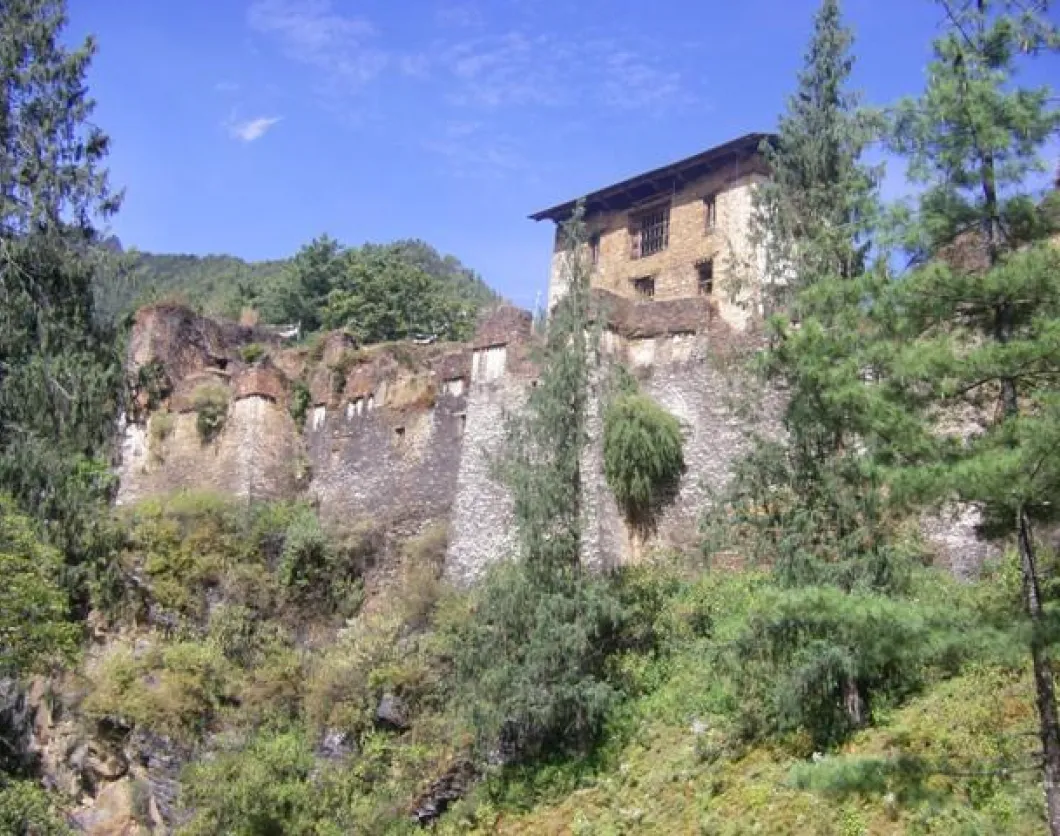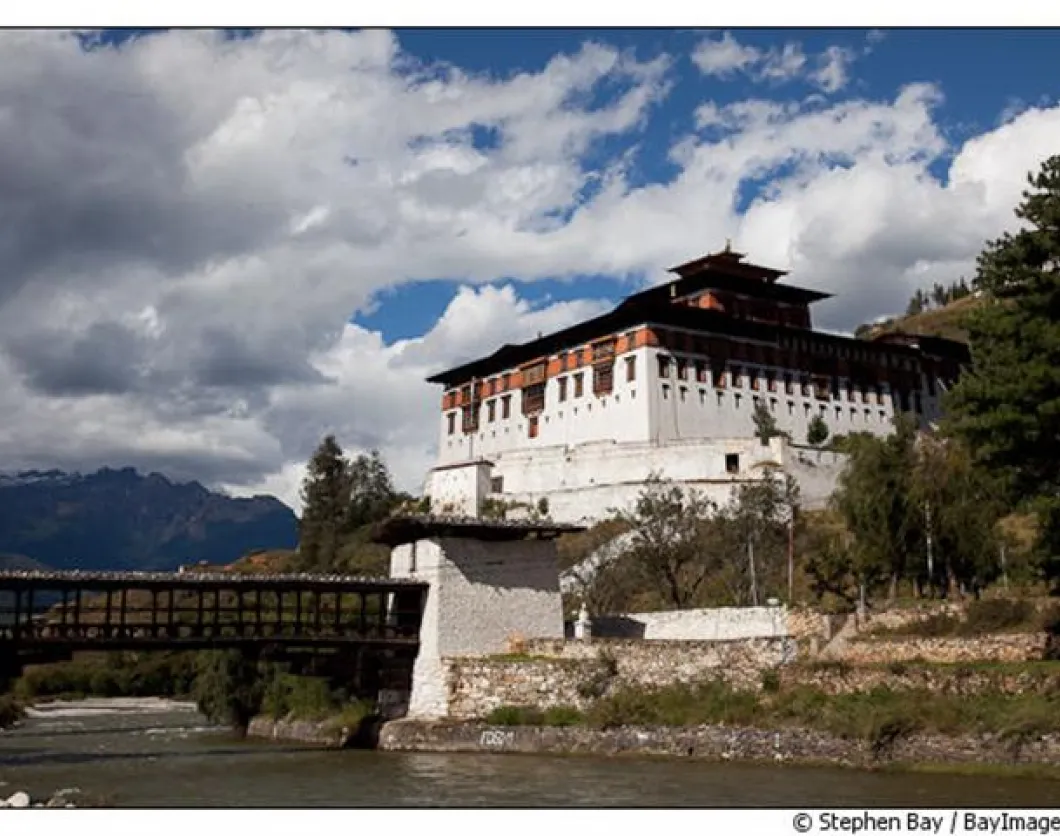The Kingdom of Bhutan – the Land of the Thunder Dragon – is regarded as one of the last Shangri-La's in the Eastern Himalayans because of its remoteness, spectacular terrain of rolling hills and towering crags, varied flora and fauna and its unique Buddhist culture all exuding immense charm.
Like timeless images from the past, the traveler encounters the full glory of this ancient land through its sacred dzongs (fortress monasteries), ancient stupas, prayer flags along mountain ridges, wild animals in dense forests, foamy white waterfalls, inspiring architecture, superb art and above all, the warm smile of its predominantly Buddhist and Dzongkha speaking people. This relatively unexplored Asian country allows limited discerning travelers to preserve its fragile environment and culture in its magical purity.
Besides the capital Thimpu, the town of Paro is an important tourist center. A flight to the verdant Paro Valley, one of the most beautiful valleys in Bhutan qualifies as one into fantasy with close up views of Mt. Everest, Kanchenjunga and other Himalayan peaks. The gurgling Paro River, originating from glacial waterways runs through rice fields, apple and peach orchards. If you fancy nature and solitude, Paro is the place. Along with Jakar and Punakha, its myriad attractions form the 'golden triangle', needing a few days to explore.
Taktsang Monastery, also called the ‘Tiger's Nest’, 80 km from Paro is precariously perched on the edge of a huge 900 m granite cliff. Overlooking the Paro Valley amidst pine forests and scattered hamlets, this monastery, one of Bhutan’s oldest ones (over a thousand years) and its unofficial symbol creates an impressive sight.
It was established as a sacred place for meditation by Guru Padmasambhava (Rinpoche) in the 7th century when he came on a flying tigress and meditated in a cave while on fast for 90 days, subduing and converting the demons from neighboring valleys to Buddhism. The monastery built in the 17th century transformed the spot as an incredibly sacred pilgrimage site.
In 1998, a tragic fire destroyed most original buildings, restored painstakingly to their former glory by the Government. The superb views and spiritual atmosphere draws every Bhutanese here at least once in a lifetime.
The 4 hr up-hill hike from the parking lot is a challenging, exhausting, thrilling and mystical experience. A cafe located on the ridge, 90 mins into the walk provides a welcome opportunity to rest and purchase snacks. From here it is another steep, strenuous walk and narrow stairs until the monastery itself. Rent a pony to go uphill (this is only one-way!) if you are not very fit or face altitude sickness. Trust on local guides to test on fitness levels, help with the climb and arrange entry permits. Taktsang is best when you are more acclimatized to altitude.
Drakhapo is a monastic complex perched on a cliff. Guru Rinpoche spent two months here after completing a retreat in Taktsang, and during his stay placed many treasures into the cliff. The area also has several hand and foot prints embedded in the rocks.
Paro Dzong or Rinpung (heap of jewels) Dzong is a Drukpa Kagyu monastery on the hillside above the gently meandering Paro Chu River with a traditional cantilever bridge. Centuries ago it was an unreachable fortress repelling invasions from Tibet. Paro Dzong is the symbolic center of religious and secular affairs of the Valley housing the Paro monastic body and administrative offices of the district commissioner and district judge. Consecrated in 1646, the dzong, an elegant and perfect symmetrical structure is an architectural wonder showcasing Bhutan’s cultural strength and housing 14 shrines and chapels. Some scenes of the Little Buddha (1993) were filmed here.
Jangsarbu Lhakhang behind Paro Dzong houses the protector deity of Paro and a magnificent statue of Sakyamuni Buddha carried from Lhasa. Legend has it that the statue destined for Paro Dzong was merely placed in the temple for overnight stay proved impossible to lift later; making it a permanent feature.
Kyichu Lhakhang or Lho Kyerchu is another important Buddhist temple, just off the road between Paro Bazaar and Taktsang. The Jowo Temple of Kyichu (7th century), one of the oldest and most sacred in Bhutan is one of the 108 border taming temples believed to be built miraculously overnight by the Tibetan Emperor Songsten Gampo. In the 8th century, Guru Rinpoche visited it and is said to have concealed spiritual treasures. Annual rites for deities Vajrasattva, Palchen Heruka and Vajrakilaya are held for the well-being of the kingdom. Two orange trees in the temple courtyard are believed to bear fruit year round.
Dukgyel Dzong, 18 km from Paro, built in the 16th century to commemorate victory over the invading Tibetans is a majestic fortress ruined by the vagaries of time and a fire. Although visitors cannot enter the ruins, it is worth seeing the monastery with the gorgeous backdrop of the Jhomolhari Mountain.
The Ugyen Pelri Palace in a secluded wooded compound to the south of the Paro River was designed by Tshering Penjor in the early 1900s after Guru Rinpoche's celestial paradise, Zangto Pelri. Being residence of the Queen Mother, public access is denied to one of the most beautiful examples of Bhutanese architecture. On the road beside Ugyen Pelri are five chortens (memorials) built in memory of the first King - Ugyen Wangchuck.
Dumtse Lhakhang is an unusual chorten-like temple (built in 1433) by the iron bridge builder Thangtong Gyalpo with three floors representing hell, earth and heaven. Some of the finest murals inside its dark interiors require a special entry permit.
Paro’s Philatellic Gallery houses a diverse collection of stamps covering a range of subjects; they are big business and an important source of foreign exchange. Bhutan issued the world’s first 3D stamps (1967) to commemorate man’s conquest of space as also those printed on hair thin steel foil, or silk with religious motifs, gold embossed coins besides ‘talking stamps’ (1973) gummed with miniature phonograph records playing the national anthem. Despite the finest stamps, runners still carry messages across the country where no roads exist.
Trekking is the best way to discover Bhutan’s verdant valleys, crystal lakes, rugged mountains and unspoilt habitat. The trails are not clearly marked and personal trekking equipment (maps, sleeping bags, kitchen paraphernalia), are not always available from trek operators.
If you are fit as a mountain goat, Kila Gompa, a magnificent cluster of temples on cliffs and home for nuns for a long time awaits you. Kila in Sanskrit means a subjugating spiritual dagger that destroys negativities. Hike up and subjugate all the negative energies within you for spiritual satisfaction. The hike itself is good enough to feel physically rejuvenated. En route, visit a local farmhouse although entrance is dependent upon the family’s discretion.
Paro tshechu (Buddhist festival around a dzong) held from the 11th-15th day of the second month of the Bhutanese lunar calendar (between March-April) is a colorful event with hundreds from the city and surrounding countryside filling the temple courtyard to watch/participate. Traditional masked dances performed by trained Buddhist monks depict life events of the Padmasambhava. There are dances of nobleman, ladies, flirting princesses (punished for their indiscretions), stags (where the hunter eventually converts to Buddhism), and those reminding one of past and present deeds influencing the future. Before dawn, on the 15th day, a giant 400 year Thongdroel banner on an appliquéd scroll, depicting Eight Manifestations of Guru Rinpoche is unfurled for a few hours before direct sunrays strike it. It is a privilege to be in Paro during this season.
Paro is dotted with souvenir shops excellent for browsing through samples of Bhutan’s traditional arts - thangka’s (holy scrolls), masks, ceramics, slate and wood carvings, metal and paper crafts, postal stamps and other interesting items. Bargaining is strongly recommended. It is illegal to take any antiques from Bhutan; consult a guide.
Markets are colorful heaps of shawls, sweaters, trinkets of turquoise and coral and Kira, the elegant, traditional Bhutanese outfit similar to a cloth wrapped around as a skirt with a jacket for the top. Paro's weekly market although not expansive is a fine introduction to some unique regional specialties as chugo (dried yak cheese) - white (boiled in milk and sun-dried) or brown (smoked), husky betel nuts (from India), exotic ferns, juniper incense, dried, jellied cow skin - khoo (local snack) and slabs of datse (cheese).
The International Airport in Paro Valley (7 km from the town) has Druk Air (Royal Bhutan Airlines), the national airline operating flights to/from Bangkok, Delhi, Kolkata, Dhaka and Kathmandu. Thimphu to Paro (30 km) is a pleasant 45 min drive; the road unfolding on every turn. With sites spread around, a vehicle is required to get around.
By Ilika Chakravarty
Academy of Business Management, Tourism and Research, Bangalore, India
10, Windmill House; 146, West Ferry Road; London, E14 3ED, U.K.










